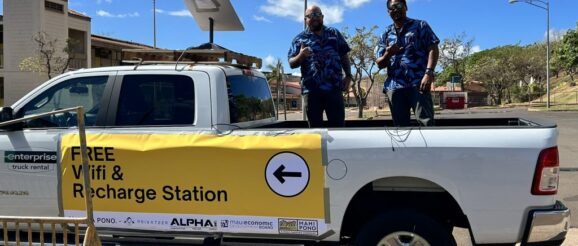Hawaiʻi defense innovation community collaborates to restore Maui connectivity after devastating wildfires

- Hawai‘i defense innovation community
collaborates to restore Maui connectivity
after devastating wildfires. PC: Pacific Impact
Zone, SMX, and the Maui Tech Hui - Hawai‘i defense innovation community
collaborates to restore Maui connectivity
after devastating wildfires. PC: Pacific Impact
Zone, SMX, and the Maui Tech Hui - Hawai‘i defense innovation community
collaborates to restore Maui connectivity
after devastating wildfires. PC: Pacific Impact
Zone, SMX, and the Maui Tech Hui - Hawai‘i defense innovation community
collaborates to restore Maui connectivity
after devastating wildfires. PC: Pacific Impact
Zone, SMX, and the Maui Tech Hui - Hawai‘i defense innovation community
collaborates to restore Maui connectivity
after devastating wildfires. PC: Pacific Impact
Zone, SMX, and the Maui Tech Hui
In the aftermath of the catastrophic wildfires that swept through Maui, a community-driven collaboration between Pacific Impact Zone, SMX, and the Maui Tech Hui worked to rapidly deploy satellite internet connectivity at key locations in West Maui.
“Witnessing the wildfires’ devastation and the subsequent breakdown of crucial telecommunications, the urgent need for reliable connectivity became immediately apparent,” said Bernice Kissinger, vice president of local Hawai’i technology nonprofit, Pacific Impact Zone (PIZ). PIZ joined forces with SMX, a prominent technology company known for its expertise in deploying communication technology in remote areas and a partner with SpaceX, which operates a constellation of telecommunications satellites.
Pooling their local insights and industry connections, the grass-roots team shipped over 50 Starlink satellite internet terminals and power generators to Maui within a few days after the fires started.
The Maui Tech Hui, which consists of the 15th Space Surveillance Squadron, large defense contractors such as Boeing and KBR, as well as commercial startups such as Privateer, responded even faster and had already deployed a handful of Starlink terminals and power, by collaborating with local Maui firms such as Mahi Pono and Alpha.
Together, the Oʻahu and Maui teams quickly coordinated their efforts which expanded the collaboration to include Hawaiian Airlines Cargo providing transport, Maui Economic Development Board which securing housing for support personnel coming to Maui, with the 15th SPSS and Maui County providing government coordination with Maui Police and Fire.
The Starlink systems, an advanced satellite internet constellation developed by SpaceX, were strategically positioned at critical locations but especially throughout Lahaina where numerous residents who sheltered in place were left with no power or communications. The internet terminals served double and triple duty, providing communications support to first responders as well as charging stations for nearby residents.
The Hawaiʻi Community Foundation provided additional support to the Maui Economic Development Board for similar communications services to help address the verified and immediate need.
Pacific Impact Zone focused on coordinating the transport and delivery of the systems and finding volunteers to assist in the set-up. “The local defense technology community is a tight-knit group and is accustomed to collaborating, so we knew once we got the ball rolling, our Oahu and Maui partners already knew how to get things done together because we’ve been doing things together for many years,” said Kevin Miyashiro, CEO at Pacific Impact Zone.
SMX’s contribution was marked by their dedication to addressing immediate needs and their holistic approach to disaster management. “As an organization deeply ingrained in the Hawaiian community, we understood the imperative to act swiftly. Our ability to provide technology solutions and the deployment of Starlink terminals was driven by our commitment to support and restore,” noted Shannon Tolliver, Vice President at SMX.
The Maui Tech Hui and their community partners worked side-by-side with personnel from SMX and SpaceX through 16-hour days to rapidly set up the terminals and power. The units were installed in vans, truck beds, homes and buildings that were left standing after the fires, bringing vitally needed communications and power to Lahaina and neighboring communities. “Maui is one giant extended family, and efforts like this show how quickly ʻohana takes care of ʻohana,” said Daron Nishimoto, a former Boeing and KBR executive that is now with Maui Economic Development Board. “We also grew our extended ʻohana with lifelong bonds with the SMX team.”
As the recovery journey unfolds, the collective focus remains steadfast on aiding the affected community. “Pacific Impact Zone, SMX, Maui Tech Hui, and so many others, stand resolute in their commitment to sharing the invaluable lessons learned, thereby enriching disaster management policies and procedures on a broader scale,” organizers said.





